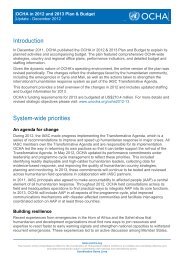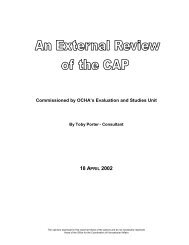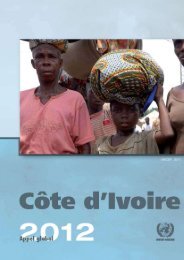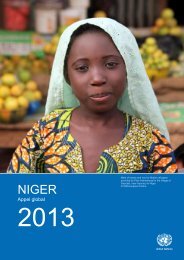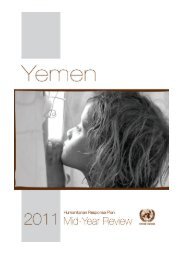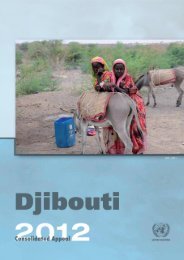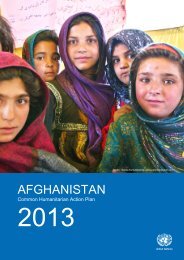Table of contents
Untitled
Untitled
Create successful ePaper yourself
Turn your PDF publications into a flip-book with our unique Google optimized e-Paper software.
58[2] NEEDS PROGRESS Analysis | sector response United Nations and PartnersSUDAN MID YEAR WORK REVIEW PLAN | Sudan 2012 work plan 2012<strong>Table</strong> <strong>of</strong> mid-year monitoring vs. objectivesOutcomes (withcorresponding targets)Outputs (with corresponding targets)Indicators (with correspondingtargets and baseline)Achieved as mid-yearObjective 1: Sustain and expand access to safe water supply for under-served and vulnerable population in areas affected by conflict, flood, drought and diseaseoutbreaks, returnees and in rural areas.Four million under-servedand vulnerable people inareas affected by conflict,flood, drought and diseaseoutbreaks, returnees and inrural areas ensured access tosafe water supply (15 litres/person/ day within one kmdistance).Water points operated and maintained, includingchlorination and water quality monitoring.Additional water points constructed.Existing water points rehabilitated.Number <strong>of</strong> people (disaggregatedby gender) with sustained access tosafe water supply (15 litres/ person/day within one km distance).Number <strong>of</strong> people (disaggregatedby gender) reached with accessto safe water supply (15 litres/person/day within one km distance)through construction <strong>of</strong> newwater points and rehabilitation <strong>of</strong>damaged water points.2,176,967 people(1,132,022 women and1,044,945 men) have gotsustained access to safewater supply.165,055 people (85,828women and 79,227 men)have access to safe watersupply from the newlyconstructed water supplyschemes.595,490 people (309,654women and 285836 men)have got safe watersupply through rehabilitation<strong>of</strong> damaged waterpoints.Objective 2: Sustain and expand access to improved sanitation for under-served and vulnerable population in areas affected by conflict, flood, drought anddisease outbreaks, and returnees in rural areas.One million under-servedand vulnerable people inareas affected by conflict,flood, drought and diseaseoutbreaks, returnee areas andin rural areas ensured accessto improved sanitation (household/community latrines).Sanitation facilities and hygienic environmentmaintained through vector control and liquidand solid waste management.New sanitation facilities constructed adoptingparticipatory and community approaches tosanitation, and damaged sanitation facilitiesrehabilitated..Number <strong>of</strong> people (disaggregatedby gender) served by vector controlmeasures.Number <strong>of</strong> people (disaggregatedby gender) served by solid wastemanagement.Number <strong>of</strong> garbage cleaningcampaigns conducted.Number <strong>of</strong> people (disaggregatedby gender) provided access toimproved sanitation throughconstruction <strong>of</strong> new sanitationfacilities and rehabilitation <strong>of</strong>damaged sanitation facilities(household/ community latrines,school and health facility latrines).Number <strong>of</strong> new latrinesconstructed.Number <strong>of</strong> latrines rehabilitated.1,070,247 people(556,528 women and513,719 men) served byvector control measures.1,702,472 people(885,285 women and817187 men) served bysolid waste management.678 garbage cleaningcampaigns conducted.241,208 people (125,428women and 115,780men) provided accessto improved sanitationthrough constructionnew and rehabilitation<strong>of</strong> damaged sanitationfacilities..9,754 new latrinesconstructed.4,108 latrines rehabilitated.Objective 3: Reach out with hygiene education for under-served and vulnerable population in areas affected by conflict, flood, drought and disease outbreaks,returnees and in rural areas.Four million under-servedand vulnerable people inareas affected by conflict,flood, drought and diseaseoutbreaks, in returnee areasand in rural areas havebetter awareness <strong>of</strong> linkagesbetween health and WASH.Number <strong>of</strong> household visits undertaken.Number <strong>of</strong> community hygiene educationcampaigns conducted.Number <strong>of</strong> Knowledge, Attitude, and Practicestudies conducted.Number <strong>of</strong> people (disaggregatedby gender) reached with hygieneeducation messages.1,898,216 people(987,072 women and911,144 men) reachedwith hygiene messagesthrough household visitsand hygiene campaigns.Objective 3: Support durable solutions that reduce aid dependence through capacity-building <strong>of</strong> communities, local authorities, and implementing partners tosustain, expand, manage, and coordinate WASH services, and water resources to improve resilience to drought, floods and emergencies.Enhanced capacity <strong>of</strong> communitymembers, and the WASHSector to manage and takecare <strong>of</strong> water, sanitation andhygiene services.1,000 community committees (Village HealthCommittee (VHC)/ Water Management Committee(WMC)/ Water Users Association (WUA), etc.)and 2,500 WASH Sector staff (individuals) trainedto sustain and manage the WASH services.Number <strong>of</strong> VHC/WMC/WUA.Community members (disaggregatedby gender) trained onmanagement <strong>of</strong> WASH services.Number <strong>of</strong> WES units establishedin localities.Number <strong>of</strong> WASH Sector staff (e.g.hand pump mechanics, motorpump operators, hygiene promoters,community mobilizers, etc.),trained on management <strong>of</strong> water,sanitation and hygiene services(disaggregated by gender).5,622 people (1,557women and 4,065 men)WUA members, communityhygiene promotersand community handpump caretakers.228 WASH sectorstaff (72 women and156 men) trained onmanagement <strong>of</strong> WASHservices.StatusOn TrackOn TrackOn TrackOn Track




